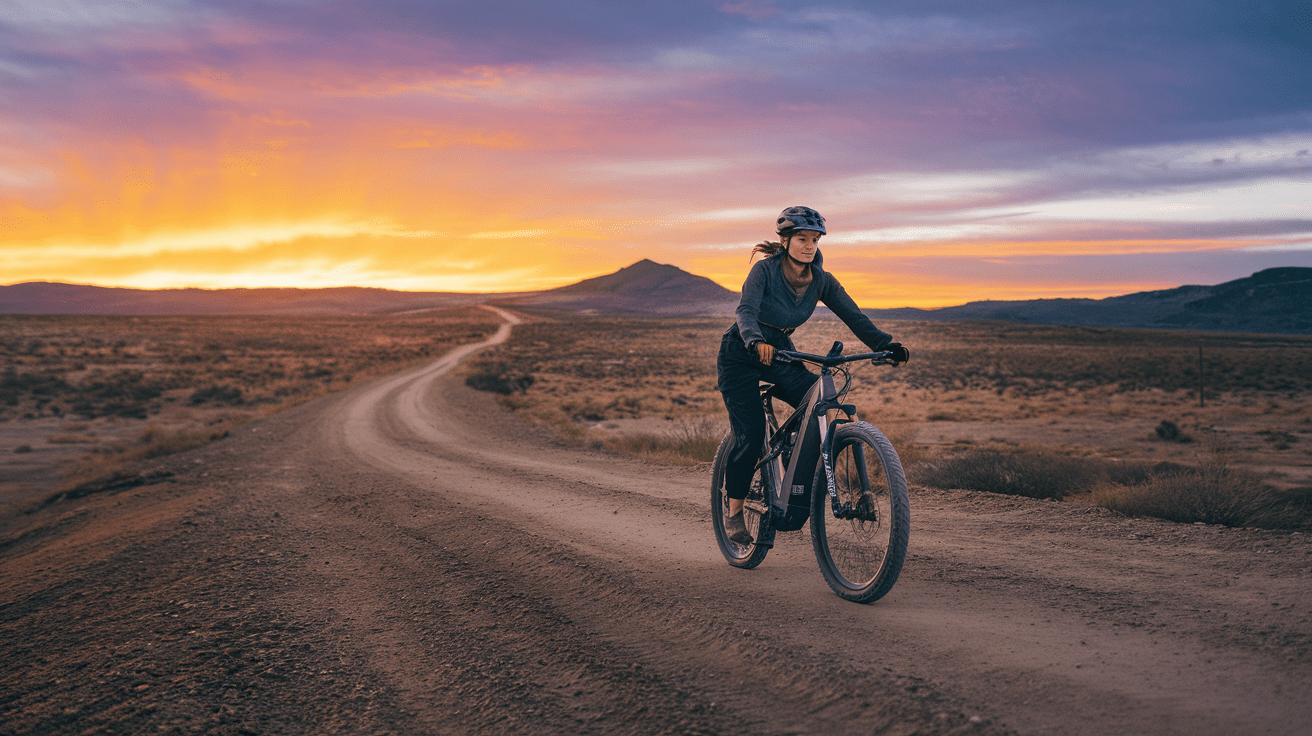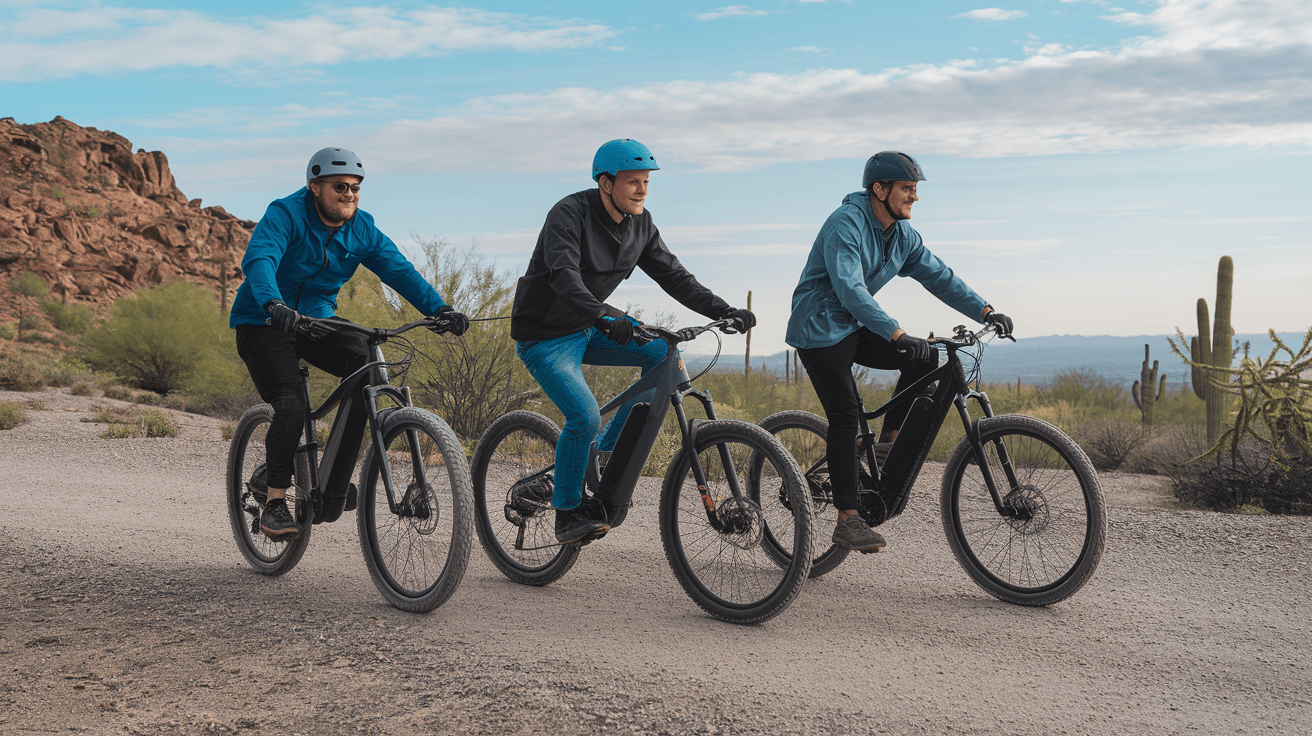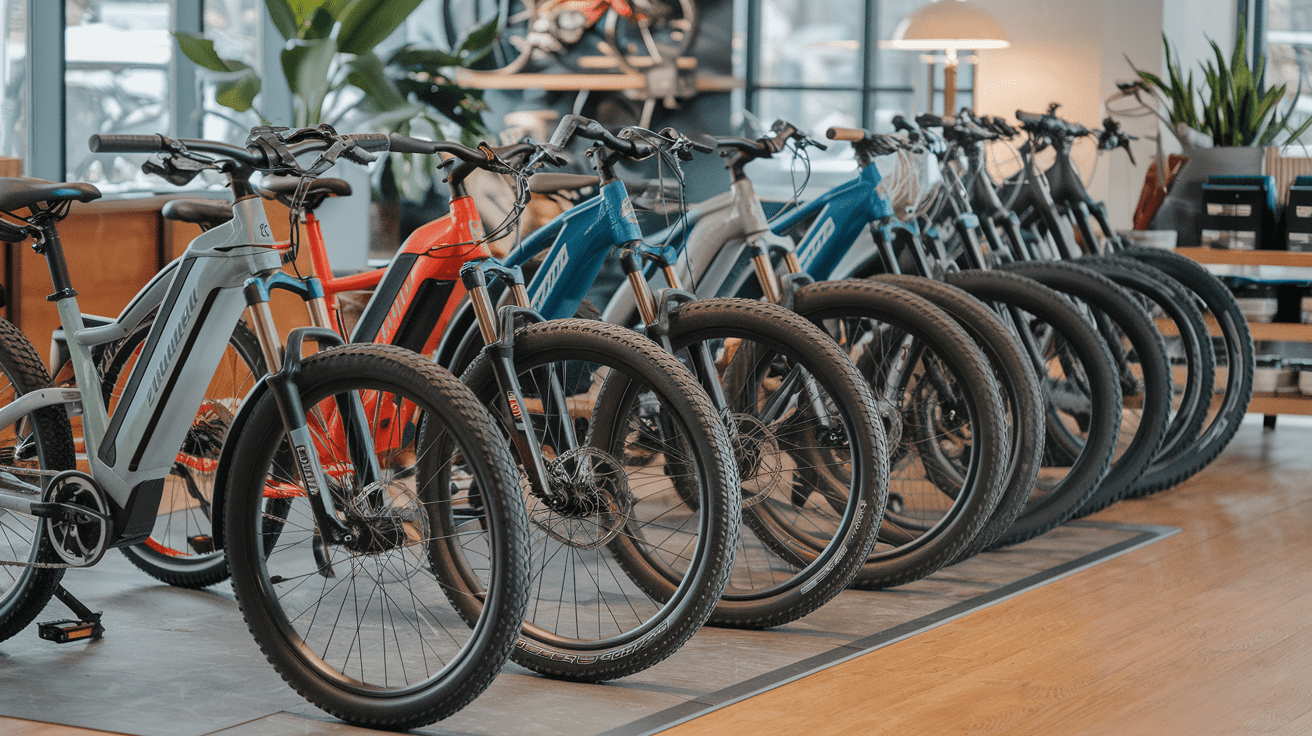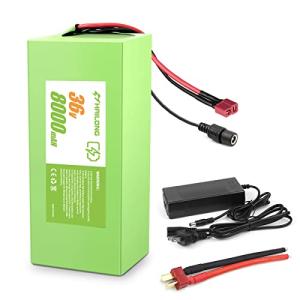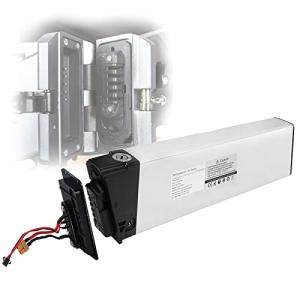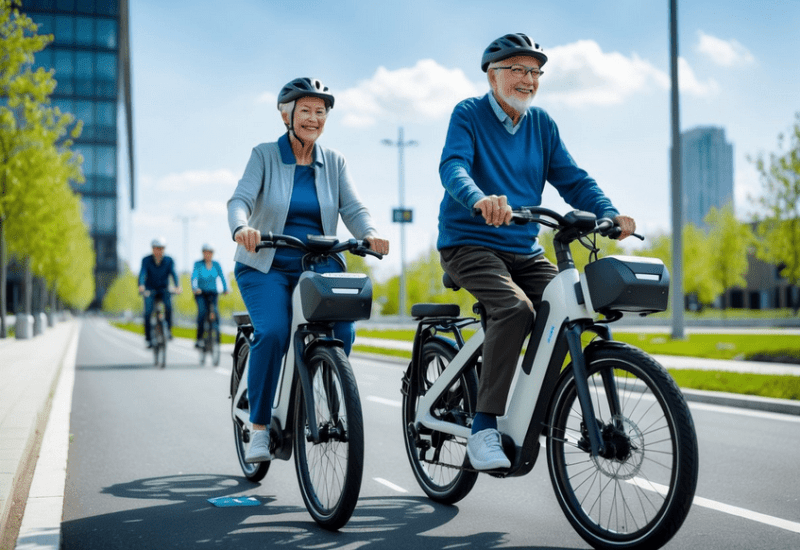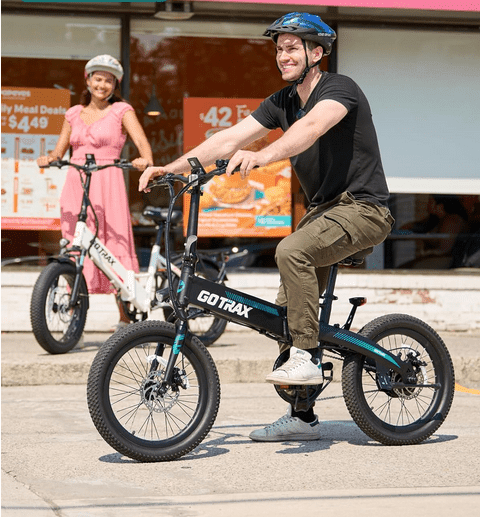Electric mountain bikes are increasingly popular for off-road adventures, including gravel riding. These powerful machines combine the rugged build of traditional mountain bikes with electric assistance that makes tackling rough terrain easier.
Electric mountain bikes generally perform exceptionally well on gravel roads due to their robust suspension systems, wider tires, and powerful motors, which provide the necessary torque to handle loose surfaces.
When riding an electric mountain bike on gravel, you'll notice the extra stability and control compared to traditional gravel-specific bikes. The added weight of the battery and motor helps keep the bike planted on loose gravel while the suspension absorbs the common bumps and vibrations on these surfaces.
Many riders find that e-MTBs offer more comfort on longer gravel rides. This is because the electric assistance reduces fatigue and allows you to enjoy the scenery without worrying about every climb.
Key Takeaways
- Electric mountain bikes offer excellent performance on gravel with their robust suspension, wider tires, and powerful motors providing necessary stability and control.
- The added weight of e-MTBs actually improves stability on loose gravel surfaces while reducing rider fatigue on longer adventures.
- Most e-MTBs are Class 1 bikes, which maintain trail access permissions. Higher classes may face limitations on certain gravel paths.
Evolution of Electric Gravel Bikes
Electric gravel bikes have transformed from simple concepts to sophisticated machines that blend off-road capability with electric assistance. These versatile rides have evolved significantly in their motor systems, battery technology, and frame designs to meet the specific demands of gravel riding.
From Traditional Gravel Bikes to Electric Assist
Traditional gravel bikes emerged as versatile options for riders seeking adventures beyond paved roads. When electric assistance entered the scene, it created a whole new category of possibilities. The genesis of e-bikes laid the groundwork for gravel-specific electric models that would follow.
Early electric gravel bikes often featured retrofitted motors on standard gravel frames. These weren't optimized for the unique demands of gravel riding. The transition wasn't just about adding motors – it required rethinking the entire bike design.
By 2020, manufacturers began developing purpose-built electric gravel bikes with integrated systems. These bikes featured motors and batteries specifically positioned to maintain the balanced handling that gravel riding demands.
The adaptation for gravel terrain required specialized engineering to handle the mixed surfaces while providing appropriate power delivery. Weight distribution became a critical factor in these designs.
Key Features of Modern Electric Gravel Bikes
Today's electric gravel bikes blend sophisticated technology with practical design elements. Modern models typically feature mid-drive motors that provide a natural riding feel rather than hub motors that can unbalance the bike on rough terrain.
Battery technology has evolved dramatically, with current models offering ranges of 60-80 miles on mixed terrain. These batteries are often integrated into the downtube for improved weight distribution and aesthetics.
Frame geometry has been optimized specifically for electric gravel riding. Modern electric gravel bikes have:
- Longer wheelbases for stability
- More upright riding positions for comfort
- Reinforced frames to handle additional motor torque
- Wider tire clearance for varying terrain
Control systems have become more intuitive, offering multiple assistance levels that riders can adjust on the fly. Many bikes now include smart features like Bluetooth connectivity and companion apps for customized riding experiences.
Performance and Capability
Electric mountain bikes offer unique advantages when tackling gravel terrain. Their powerful motors and specialized designs enhance rider experience across varied conditions while maintaining stability and control.
Traction and Stability on Gravel
Electric mountain bikes excel on gravel surfaces due to their wider, knobby tires that provide superior grip compared to traditional road bikes. The increased contact patch significantly improves traction on loose surfaces, preventing wheel spin and maintaining control even on steep inclines.
We've found that most eMTBs feature advanced suspension systems that absorb impacts from uneven gravel terrain. This reduces rider fatigue and keeps the wheels in contact with the ground, enhancing stability and control.
The lower center of gravity created by the battery placement in most models further increases stability. This design feature is especially beneficial when navigating challenging gravel descents or corners where traditional bikes might feel twitchy or unstable.
Many riders appreciate how the added weight of an eMTB actually contributes to improved traction in loose conditions, allowing for more confident handling on unpredictable surfaces.
Impact of Motor and Battery on Performance
Most electric mountain bikes use a mid-drive motor that delivers power directly to the drivetrain rather than the wheel hub. This configuration provides more natural handling and better weight distribution when riding on gravel.
The typical 250W motor found in Class 1 eMTBs offers sufficient power for most gravel adventures. In high-power modes, these motors can provide up to 340% assistance, delivering enough torque to conquer steep gravel climbs with ease.
Battery capacity significantly impacts performance range on gravel routes. Larger batteries enable longer adventures but add weight. Most modern eMTBs balance capacity and weight to maintain agility on varied terrain.
Motor assistance on gravel is particularly valuable when facing headwinds or maintaining momentum through soft sections. We've observed that the powerful torque output helps riders maintain consistent speeds without excessive exertion.
Multiple assist modes allow for customization of power delivery, allowing riders to conserve battery on flat sections and maximize support on challenging terrain.
Ride Experience and Comfort
The ride experience on an electric mountain bike over gravel terrain depends significantly on the bike's construction and setup. Frame materials play a crucial role in shock absorption, while weight distribution affects how the bike handles on loose surfaces.
Frame Materials and Ride Quality
Electric mountain bikes with carbon fiber frames offer superior ride quality on gravel paths. Carbon frames absorb vibrations better than aluminum, making for a smoother experience over rough terrain. The natural dampening properties of carbon reduce hand and arm fatigue during longer rides.
We've found that bikes with carbon frames typically provide a more responsive feel when transitioning between pavement and gravel. This responsiveness translates to better control in unpredictable conditions.
Many premium e-mountain bikes now feature specially designed carbon layups that balance stiffness and compliance. This engineering creates a bike that's rigid enough for efficient pedaling but comfortable enough for extended gravel adventures.
Influence of Weight Distribution on Handling
Weight distribution is critical when riding electric mountain bikes on gravel. The location of the motor and battery significantly affects stability and maneuverability.
Mid-drive motors position weight centrally, creating a balanced feel that's particularly helpful on loose gravel. Hub motors, while simpler, can make the bike feel rear-heavy and potentially less stable when climbing loose surfaces.
Battery placement also impacts handling. Low-mounted batteries lower the center of gravity, improving stability on unpredictable gravel surfaces. We recommend bikes with integrated down-tube batteries for optimal weight balance and handling.
The extra weight of electric components can actually be beneficial on gravel, as the added mass helps maintain momentum through loose sections and provides more traction in corners.
Components and Technology Highlights
Electric mountain bikes for gravel riding feature specialized components that enhance performance across varied terrain. These technological innovations balance power, control, and durability to create versatile riding experiences.
Shimano GRX and Hydraulic Disc Brakes
Shimano GRX groupsets, with their gravel-specific designs, have revolutionized the e-gravel bike experience. The GRX components offer wider gear ratios that help riders tackle steep climbs and maintain control on descents. These groupsets come in various configurations (RX400, RX600, and RX800) to match rider needs and bike specifications.
Hydraulic disc brakes are essential for e-gravel bikes, providing reliable stopping power in all conditions. Unlike mechanical systems, hydraulic brakes require less finger effort while delivering superior modulation. This precision becomes critical when navigating loose gravel descents or sudden obstacles.
Notable features include:
- Expanded brake pad clearance to prevent mud buildup
- Ergonomic lever designs specifically for off-road control
- Heat management systems for consistent performance on long descents
Integration of Mid-Drive Motors and Battery Systems
The heart of any e-gravel bike lies in its motor and battery configuration. Mid-drive motors like the Bosch Performance Line Speed and Fazua Ride 60 motor have become industry standards for their balanced weight distribution and natural riding feel.
These systems place the motor at the bike's bottom bracket, maintaining the optimal center of gravity. This positioning is crucial for gravel riding where stability directly impacts control and confidence.
Battery integration has also evolved significantly, with many models featuring:
- Removable batteries for easy charging
- Range-extending options for longer adventures
- Smart integration with frame designs for improved aerodynamics and protection
Pedal assist systems now offer multiple support levels, typically ranging from eco (30-50% assistance) to turbo (300%+ assistance). More sophisticated systems include automatic adjustment based on terrain, cadence, and rider input.
Models and Brands
The electric gravel bike market offers diverse options from established manufacturers and innovative newcomers. These bikes combine off-road capability with electric assistance to enhance the riding experience across varied terrain.
Comparing Top Electric Gravel Bikes
Several models consistently stand out when looking for the best electric gravel bikes. The Ribble CGR AL delivers exceptional value with its lightweight aluminum frame and customizable spec options. We've found it performs admirably on gravel paths and light singletrack.
The Cannondale Topstone Neo 5 impresses with its balanced handling and reliable Bosch motor system. Its comfortable geometry makes it ideal for longer adventures where mixed terrain is expected.
Santa Cruz Bicycles' Skitch has quickly become a favorite among riders seeking more aggressive handling. The Santa Cruz Skitch features trail-oriented geometry and powerful motor assistance that excels on technical descents while maintaining efficiency on flatter sections.
Each of these models offers distinct advantages depending on your riding style:
- Ribble CGR AL: Best for value and versatility
- Cannondale Topstone Neo: Ideal for comfort on long rides
- Santa Cruz Skitch: Superior for technical terrain
Emerging Brands and Innovations
The electric gravel bike segment continues to evolve with exciting innovations from newer companies.
Smaller manufacturers are challenging established brands with unique features and specialized designs.
Battery technology is advancing rapidly. Some newer models offer impressive range even when riding over varied terrain.
Integrated systems that blend seamlessly with frame designs are becoming more common.
We're seeing interesting developments in motor placement and power delivery. Mid-drive motors remain dominant, but hub-based systems are improving in responsiveness and efficiency.
Several brands now offer frames with adjustable geometry. This allows riders to optimize their position for either speed or stability depending on conditions.
Smart connectivity features are also becoming standard. Apps provide detailed ride metrics and customizable assistance levels.
Weight reduction remains a key focus. Some new models are approaching the weight of non-electric gravel bikes while maintaining substantial power assistance.
Practical Aspects of Use
Understanding battery management and maintenance routines can significantly enhance your experience when riding electric mountain bikes on gravel.
These practical considerations ensure you get the most out of your rides without unexpected interruptions.
Range and Battery Life
Electric mountain bikes typically offer good range on gravel terrain, though the actual distance varies based on several factors.
Most models equipped with a 500wh battery will provide 20-50 miles of assistance, depending on:
- Assistance level used (higher levels drain the battery faster)
- Terrain steepness (climbing consumes more power)
- Rider weight and cargo
- Weather conditions (headwinds and cold temperatures reduce efficiency)
We recommend maintaining steady momentum rather than frequent stops and starts, which can preserve battery life.
Many newer models offer range extender options that can nearly double your riding distance.
Carrying a spare battery might be worth the extra weight for long gravel adventures.
Maintaining and Charging Your Electric Gravel Bike
Proper maintenance ensures reliable performance on rough gravel surfaces. After rides, we suggest:
- Cleaning dirt and debris from moving parts
- Checking tire pressure (lower for gravel, higher for pavement)
- Inspecting the drivetrain for wear
Charging typically takes 3-6 hours for a full cycle. Modern electric bikes have smart charging systems that prevent overcharging. We recommend:
- Charging after rides rather than letting the battery sit empty
- Storing batteries at 40-80% charge if not using for extended periods
- Avoiding extreme temperatures during charging and storage
Regular maintenance checks of connectors and electrical components are essential, especially after riding in wet or muddy conditions. This preventive care significantly extends battery lifespan.
Frequently Asked Questions
Electric mountain bikes offer unique capabilities on gravel surfaces that many riders want to understand before making a purchase. Here are answers to common questions about using these versatile machines on gravel terrain.
What features should I look for in an electric mountain bike for gravel riding?
When selecting an electric bike for gravel riding, tire width is crucial. Look for tires between 40-50mm wide that provide stability without excessive drag.
Suspension is another important consideration. A front suspension fork with 80-120mm of travel offers enough cushioning for gravel roads while maintaining efficiency.
Battery capacity should match your typical ride distance. We recommend at least 500Wh for longer gravel adventures to ensure you don't run out of power mid-ride.
How do electric gravel bikes perform compared to traditional gravel bikes?
Electric gravel bikes provide significant advantages on challenging terrain. They help maintain consistent speeds on varied surfaces where traditional bikes might struggle with momentum.
Motor assistance reduces fatigue on long rides, allowing riders to cover more distance and tackle steeper climbs with less effort.
This is especially beneficial on loose gravel where extra power helps maintain traction.
We've found that electric assistance doesn't compromise the handling characteristics that make gravel riding enjoyable. Most quality e-gravel bikes preserve the responsive feel of traditional models.
What are the benefits of using an electric mountain bike on gravel trails?
Electric mountain bikes extend your riding range significantly. The motor assistance lets you explore further without worrying about having enough energy for the return journey.
They also make gravel climbs more accessible. Steep, loose sections that might be challenging on conventional bikes become manageable with electric assistance.
Recovery between challenging sections is faster with an e-bike. The motor help allows your muscles to recuperate while maintaining good speed, making the overall riding experience more enjoyable.
Are there specific brands that are recommended for electric mountain bikes on gravel surfaces?
Several manufacturers excel in the electric gravel bike market.
Specialized offers models with well-tuned motor systems that provide natural-feeling assistance on varied terrain.
Trek produces e-mountain bikes with excellent battery integration and range, ideal for longer gravel adventures. Their suspension tuning works particularly well on rough gravel roads.
Canyon and Giant offer strong value propositions with capable motors and frame geometries specifically designed for mixed-terrain riding, including gravel surfaces.
How does the battery life of an electric mountain bike fare on long gravel rides?
Battery performance varies based on several factors. Most modern e-bikes offer 40-80 miles of range, but this decreases on loose gravel due to increased resistance and power demands.
Using lower assistance levels substantially conserves battery life. We've found that alternating between eco and medium settings can extend range by up to 30% on gravel rides.
Temperature significantly affects battery performance. Cold weather below 40°F can reduce capacity by 20-30%, so plan accordingly for winter gravel adventures.
What are the maintenance considerations for electric mountain bikes used predominantly on gravel?
Gravel riding creates more dust and debris than road cycling. To prevent premature wear, we recommend cleaning your drivetrain and electrical connections after every dusty ride.
Tire pressure needs to be checked regularly for gravel riding. Lower pressures (25-35 psi) improve traction and comfort but increase the risk of pinch flats. Tubeless setups are highly recommended to prevent this.
Battery maintenance is essential for longevity. If you do not ride for extended periods, store your e-bike with the battery at approximately 50% charge. Also, avoid leaving it in extremely hot or cold environments.

